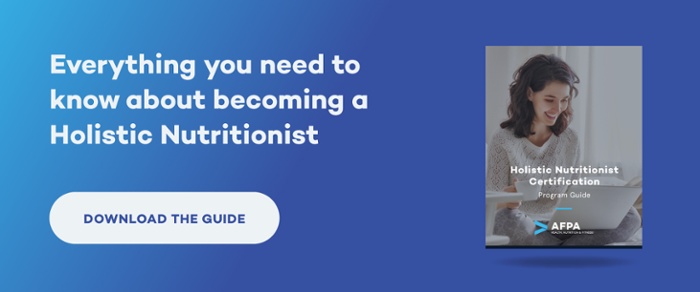Demand for health and wellness is higher than ever, and growing fast. The Global Wellness Institute, a research firm that focuses on areas like healthy eating, fitness, and anti-aging efforts, notes that wellness is a $3.4 trillion market. That makes it nearly three times larger than the $1 trillion worldwide pharmaceutical industry.
According to research firm Technavio, we can expect steady growth of at least 6 percent from 2016 through 2020. Another research organization, Nielsen, notes in a recent report that “most consumers are more interested in staying out of the doctor’s office than they are about scheduling their next physical.” That’s leading many people to take charge of their nutrition and fitness goals in meaningful, long-term ways.
Become a Certified Holistic Nutritionist Online in 6 Months or Less
That opens up huge opportunities for those who specialize in health and wellness. From personal trainers to nutrition experts, professionals in the wellness field can expect steady client growth, especially if they keep expanding their services. How can you take advantage of the boom? Here are five possibilities to consider.
1. Get a certification
What are you most passionate about? Taking the time to truly think about that question can lead you to explore options for a certification program. For example, you might want to become a group fitness instructor if you’ve found yourself going to classes and brainstorming ways you’d put your own class together. Or if you seem to be the go-to friend for nutrition advice, you can turn your enthusiasm for healthy eating into an actual career.
Whatever you choose, a certification from an accredited organization gives you the extensive knowledge you need to excel in the field, and also assures your clients that you’ve received superior training. Another advantage to certification is that you can get your education much faster and more affordably than you’d find with a four-year college degree. Plus, in a certification program, you’ll be learning only about your new field, rather than studying the kind of non-relevant “foundation” courses that many colleges require.
2. Make a career change
With a certification, you can consider taking the step toward a new career in the health and wellness industry.
Make a solid plan that includes narrowing down your choices, picking a specialty, determining your strengths, and understanding your resources. Once you see how many opportunities there are in the health and wellness industry, you’ll be excited and energized for your fresh new career.
3. Start a side job
If you’re not ready to leave your current career for health and wellness, consider making your role as a trainer or nutrition professional into a side business that you could do on evenings and weekends.
Some in health and wellness “meet” with clients over video chat, which means that not only can you see clients from anywhere, but you can also set your own schedule when it comes to fitting this new side job into your life.
4. Team up with other health professionals
If you’re a personal trainer, you could connect with nutrition professionals to offer more for your clients—and that contact would, in turn, send his or her clients your way as well.
The more often you can team up, the more you can expand your services, which will be very attractive to clients who are looking for advice on fitness, training performance, nutrition, and other health strategies.
5. Expand your knowledge
With certifications, you can get an initial education in a field, and then move on to more advanced training that will help you deepen your knowledge or expand what you offer.
For instance, you could earn a personal trainer certification and then go after a weight loss specialist certification if you find that many of your clients are struggling with weight issues. You can also specialize in certain populations, like youth or seniors. The more certifications you earn, the greater your knowledge base will be, and the more opportunities you might find.
To learn more about AFPA’s certification programs, visit our programs site. We also created the Career Change Guide to give you more insights.




